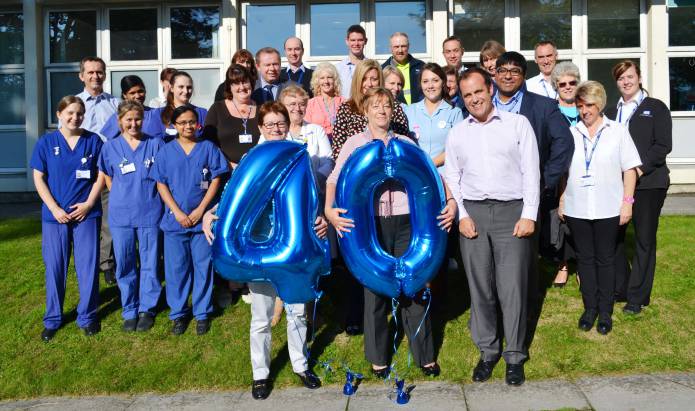Yeovil Hospital reaches the Big 40!

THERE have been celebrations at Yeovil District Hospital after it reached its 40th anniversary milestone since the main building was first officially opened.
The Duchess of Kent opened the hospital's main building on October 15, 1973, to become the tallest building in Yeovil. It was designed to make an architectural impact, as well as providing the very latest NHS care.
The extension to the Accident and Emergency Department is one of the first additions to the hospital, which was officially opened by HRH the Duke of Gloucester, in May 2002.
The first £1million Flying Colours Appeal, launched in May 2004, was sponsored by Screwfix Direct and enabled the hospital to transform the patient environment.
PHOTO - TOP: Staff at Yeovil District Hospital celebrate the hospital's 40th anniversary.
In 2006 the hospital became a Foundation Trust changing its’ name from East Somerset NHS Trust to Yeovil District Hospital NHS Foundation Trust which was one of the greatest organisational changes in the history of the hospital. This change was announced on June 1, 2006, following a lengthy application process. The hospital had to demonstrate the highest standards of clinical and financial performance.
NHS Foundation Trusts have more freedom from central controls (e.g. greater financial independence) and they give local people more chance than ever before to have a say in how services are run, through membership and an elected Board of Governors.
The opening of a prestigiou new learning facility to train the healthcare professionals of the future took place in 2006. The Academy was opened in May 2006 by HRH the Duke of Kent. It included state-of-the art “telemedicine” equipment able to link medical experts around the globe. This suite was opened by award-winning actor James Purefoy – who once worked at the hospital as a porter.
 Growing demands on services led to an £8 million expansion in Critical Care facilities for the most seriously ill patients. This was completed in February 2007.
Growing demands on services led to an £8 million expansion in Critical Care facilities for the most seriously ill patients. This was completed in February 2007.
Today the hospital serves a population of over 200,000 people in Somerset and Dorset.
Each year more than 37,000 patients are treated as inpatients or day cases; more than 169,000 attend outpatient appointments; around 47,000 are treated in Accident and Emergency, and about 1,600 babies are born in the Maternity Unit.
In 1973 the hospital saw 14,380 A&E attendances and in 2012/13 the hospital saw 47,649 people coming into A&E an increase of 231%.
The average length of stay for women having a baby in 1973 was 11 days. In 2013 the average length of stay for a woman having a baby in 2013 is two days.
The hospital's chief executive, Paul Mears, said: "The hospital has seen many changes in the last 40 years and is sure to see many more in the next 40 years with rapid advances in medicine and technology.
"Our job is to ensure the needs of the local people are met with the services we provide at the hospital. Our challenge is to provide these services in a sustainable manner with the support of a great workforce and our local community.”
Tags:
News.
Recent Posts
 YEOVIL NEWS: Police appeal for witnesses after man threatened and forced into a vehicle
YEOVIL NEWS: Police appeal for witnesses after man threatened and forced into a vehicle YEOVIL NEWS: Alan’s poetry goes into print – at the age of 86
YEOVIL NEWS: Alan’s poetry goes into print – at the age of 86 YEOVIL NEWS: Police reassure public after armed officers arrest man in Yeovil
YEOVIL NEWS: Police reassure public after armed officers arrest man in Yeovil YEOVIL NEWS: Yeovil Celebrates free event planned to take place again in 2024
YEOVIL NEWS: Yeovil Celebrates free event planned to take place again in 2024 YEOVIL NEWS: Wonderful Wiek’s still going strong at 80 and 60 years as Dale Fender
YEOVIL NEWS: Wonderful Wiek’s still going strong at 80 and 60 years as Dale Fender YEOVIL NEWS: Breast cancer unit appeal hits £2.4m – thanks to ladies that lunch!
YEOVIL NEWS: Breast cancer unit appeal hits £2.4m – thanks to ladies that lunch! YEOVIL NEWS: Vicar says he hopes defibrillator never has to be used for an emergency
YEOVIL NEWS: Vicar says he hopes defibrillator never has to be used for an emergency YEOVIL NEWS: Growing Pains brought dance alive and left me transfixed by its creativity
YEOVIL NEWS: Growing Pains brought dance alive and left me transfixed by its creativity YEOVIL NEWS: A good teacher is like a candle and Ken Davy illuminated the classroom
YEOVIL NEWS: A good teacher is like a candle and Ken Davy illuminated the classroom YEOVIL AREA NEWS: Chinnock Hollow to remain closed to traffic after £2.7million repair price tag
YEOVIL AREA NEWS: Chinnock Hollow to remain closed to traffic after £2.7million repair price tag YEOVIL AREA NEWS: Man exposes himself at Ham Hill
YEOVIL AREA NEWS: Man exposes himself at Ham Hill YEOVIL NEWS: The panto is such good fun we had to go and watch for a second time!
YEOVIL NEWS: The panto is such good fun we had to go and watch for a second time! YEOVIL NEWS: Evolution never fails to disappoint with panto magic at the Octagon
YEOVIL NEWS: Evolution never fails to disappoint with panto magic at the Octagon RIP QUEEN ELIZABETH II: Public invited to lay floral tributes at St John’s churchyard in Yeovil
RIP QUEEN ELIZABETH II: Public invited to lay floral tributes at St John’s churchyard in Yeovil RIP Queen Elizabeth II – who served the UK and Commonwealth with such distinction
RIP Queen Elizabeth II – who served the UK and Commonwealth with such distinction

















